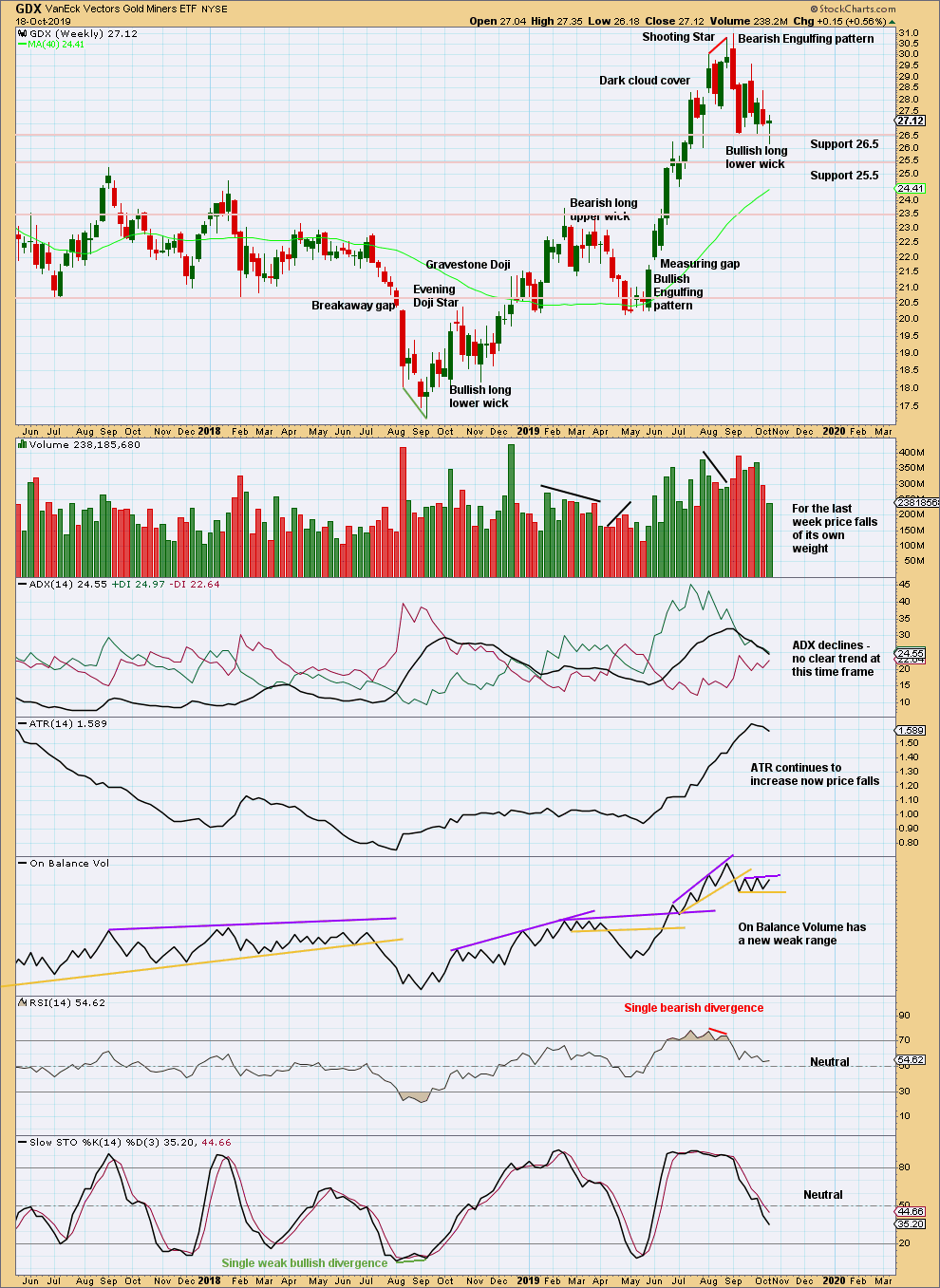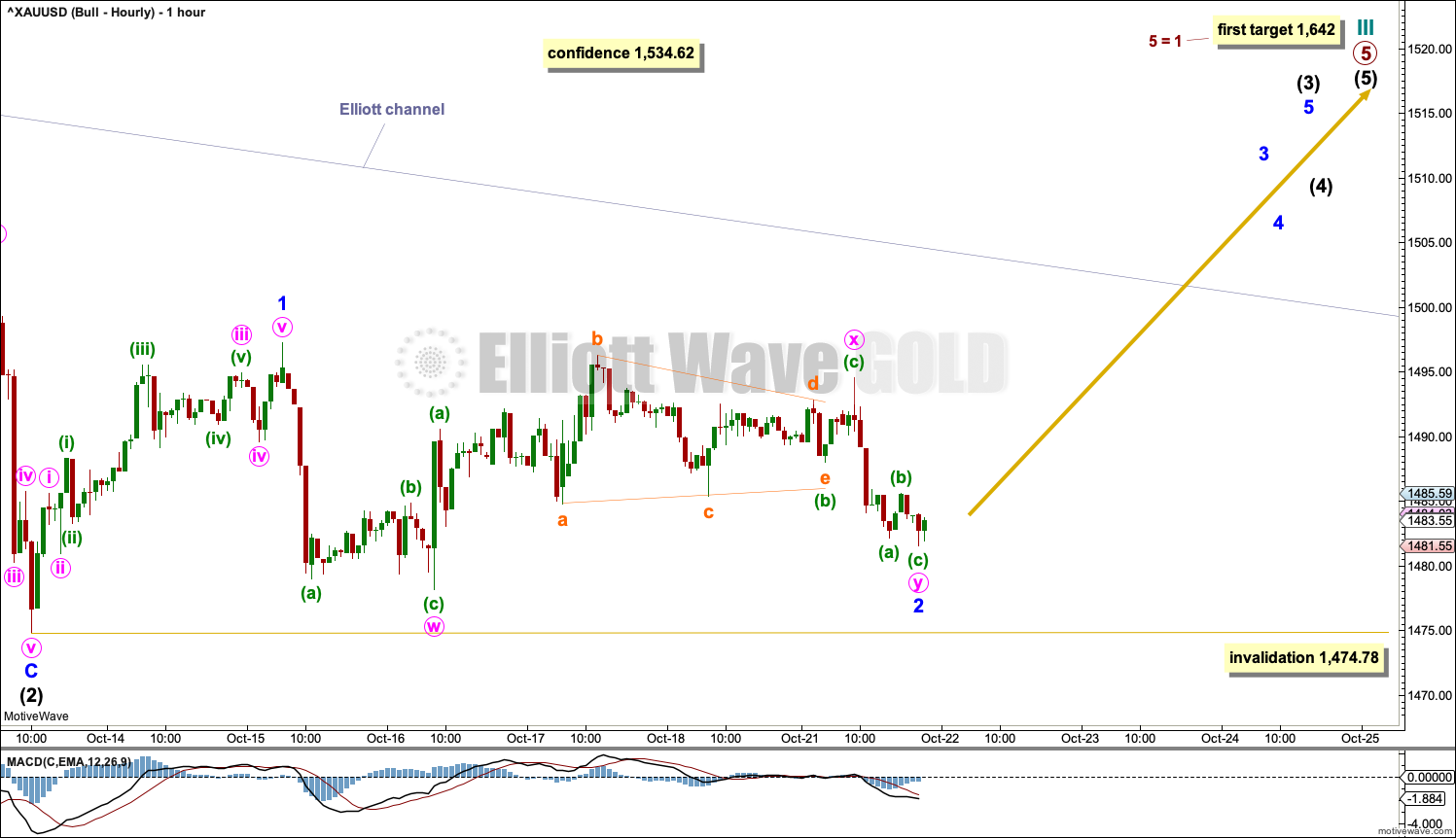A small range day remains within the pennant trend lines. Targets remain the same.
Summary: A downwards breakout may happen this week. A new low below 1,456.64 would provide confidence that the downward trend has resumed. The short-term target may be at 1,420 (Elliott wave) or 1,407 (from the pennant pattern). The main Elliott wave count still expects downwards movement to continue this week.
A new high above 1,534.62 would add confidence to a more bullish outlook at least for the short term. The target would then be at 1,567, 1,652 or 1,693.
For the bigger picture, the bearish Elliott wave count expects a new downwards trend to last one to several years has begun already, or may begin after one more high. Confidence in this view may be had if price makes a new low by any amount at any time frame below 1,346.45.
The bullish Elliott wave count expects a primary degree fourth wave has completed and the upwards trend has resumed.
Grand SuperCycle analysis is here.
Monthly charts were last published here.
BEARISH ELLIOTT WAVE COUNT
WEEKLY CHART
It is possible that Super Cycle wave (b) is complete as a double zigzag.
The first zigzag in the double is labelled cycle wave w. The double is joined by a three in the opposite direction, a triangle labelled cycle wave x. The second zigzag in the double is labelled cycle wave y.
The purpose of the second zigzag in a double is to deepen the correction. Cycle wave y has achieved this purpose.
A new low below 1,346.45 would add strong confidence to this wave count. At that stage, the bullish Elliott wave count would be invalidated.
A wide best fit channel is added in light blue. This channel contains all of Super Cycle wave (b) and may provide resistance and support. Copy this channel over to daily charts.
DAILY CHART
Cycle wave y may be a complete zigzag. Within both of primary waves A and C, there is good proportion between intermediate waves (2) and (4). Within both of primary waves A and C, there is good alternation in structure of intermediate waves (2) and (4).
Within cycle wave y, there is no Fibonacci Ratio between primary waves A and C.
Draw a base channel on daily and hourly charts about minor waves 1 and 2. Draw the first trend line from the start of minor wave 1 to the end of minor wave 2, then place a parallel copy on the end of minor wave 1. The upper edge of this channel is where price is currently finding resistance. Look for any bounces this week to find strong resistance again at the upper edge of this channel. Along the way down, minor wave 3 should exhibit enough power to break below support at the lower edge of the base channel.
Gold usually fits within base channels at the start of new movements but not always. Occasionally second wave corrections can be deep and time consuming and can breach base channels.
HOURLY CHART
Minor wave 3 may only subdivide as an impulse. Within minor wave 3, minute waves i and ii may be complete.
Minute wave iii may only subdivide as an impulse. Within minute wave iii, minuette wave (ii) may be complete. Within minuette wave (iii), subminuette waves i and ii may be complete. Within subminuette wave iii, no second wave correction may move beyond the start of its first wave above 1,494.57.
This wave count now sees a series of four overlapping first and second waves complete. A strong increase in downwards momentum is expected to arrive sooner rather than later, after a downwards breakout below support.
ALTERNATE DAILY CHART
This wave count exactly follows the expected pathway for Silver. If your own analysis suggests these markets should move together (although the correlation co-efficient shows they do not always do so), then this may be your preferred Elliott wave count.
It is possible that the double zigzag for Super Cycle wave (b) may be incomplete and may yet require one more high. A target is calculated for primary wave C that expects resistance at the upper edge of the light blue best fit channel to continue.
Within cycle wave y, primary wave A may have been over at the last high. Primary wave B may now be a complete zigzag. Primary wave C may have begun. Within primary wave C, intermediate wave (2) may not move beyond the start of intermediate wave (1) below 1,456.64.
A channel is drawn about cycle wave y using Elliott’s technique for a correction. At this stage, the lower edge of this channel should provide strong support for pullbacks within primary wave C. If this channel is breached by downwards movement, then the probability of this wave count would reduce substantially.
At the hourly chart level, this wave count would look the same as the bullish hourly chart below except for the target.
BULLISH ELLIOTT WAVE COUNT
WEEKLY CHART
This wave count sees the the bear market complete at the last major low for Gold in November 2015.
If Gold is in a new bull market, then it should begin with a five wave structure upwards on the weekly chart. However, the biggest problem with this wave count is the structure labelled cycle wave I because this wave count must see it as a five wave structure, but it looks more like a three wave structure.
Commodities often exhibit swift strong fifth waves that force the fourth wave corrections coming just prior and just after to be more brief and shallow than their counterpart second waves. It is unusual for a commodity to exhibit a quick second wave and a more time consuming fourth wave, and this is how cycle wave I is labelled. This wave count still suffers from this very substantial problem, and for this reason the bearish wave count is still considered because it has a better fit in terms of Elliott wave structure.
Cycle wave II subdivides well as a double combination: zigzag – X – expanded flat.
Cycle wave III may have begun. Within cycle wave III, primary waves 1 and 2 may now be complete. Primary wave 3 has now moved above the end of primary wave 1 meeting a core Elliott wave rule. It has now moved far enough to allow room for primary wave 4 to unfold and remain above primary wave 1 price territory. Primary wave 4 may not move into primary wave 1 price territory below 1,346.45.
Cycle wave III so far for this wave count would have been underway now for 62 weeks. It is beginning to exhibit some support from volume and increasing ATR. This wave count now has some support from classic technical analysis.
The channel drawn about cycle wave III is an adjusted Elliott channel. The lower edge is pulled lower.
Add the wide best fit channel to weekly and daily charts.
DAILY CHART
Primary wave 3 today is relabelled as complete at the last high for Gold. This labelling gives a better Fibonacci ratio between primary waves 1 and 3; primary wave 3 is now 14.63 short of 1.618 the length of primary wave 1. This relabelling makes no difference to targets or the invalidation point.
Primary wave 4 is possibly complete. The structure now fits as a zigzag. It is possible that primary wave 4 could continue lower as a double zigzag.
Primary wave 2 lasted 43 sessions. Primary wave 4 may have been over in 19 sessions.
Primary wave 4 may not move into primary wave 1 price territory below 1,346.45.
HOURLY CHART
Primary wave 4 may be complete and primary wave 5 upwards may be underway. Primary wave 5 may subdivide either as an impulse or an ending diagonal. An impulse is much more likely.
Within the impulse, intermediate waves (1) and (2) may be complete.
Intermediate wave (3) may have begun. Within intermediate wave (3), no second wave correction may move beyond the start of its first wave below 1,474.78.
TECHNICAL ANALYSIS
WEEKLY CHART

Click chart to enlarge. Chart courtesy of StockCharts.com.
When trends reach very extreme, candlestick reversal patterns should be given weight. The Dark Cloud Cover bearish reversal pattern is given more bearish weight from the long upper wick.
This pullback has brought RSI and Stochastics down from overbought and ADX down from very extreme. It looks like a high may be in place for Gold, but it is also possible that one final high may yet be seen before a major trend change.
Last week a small range inside week leaves this view unchanged.
DAILY CHART

Click chart to enlarge. Chart courtesy of StockCharts.com.
Since the last high on the 4th of September, there has been a new swing low (on the 30th of September) and now a series of (so far) two lower swing lows and two lower swing highs. In conjunction with a very strong Bearish Engulfing pattern on the 5th of September and the prior upwards trend reaching very extreme, it looks like Gold may have had a trend change.
A pennant pattern may be forming. Pennants are reliable continuation patterns. A downwards breakout is expected shortly. The best performing pennants (and flags) complete within 15 sessions. This one so far has lasted 14 sessions. A target would be at 1,407.
GDX WEEKLY CHART

Click chart to enlarge. Chart courtesy of StockCharts.com.
For the very short term, a decline in volume and a long lower wick last week suggest a bounce this week.
GDX DAILY CHART

Click chart to enlarge. Chart courtesy of StockCharts.com.
There is now a series of three lower highs and three lower lows from the high on the 4th of September. It still looks like GDX may have had a trend change.
Published @ 10:05 p.m. EST.
—
Careful risk management protects your trading account(s).
Follow my two Golden Rules:
1. Always trade with stops.
2. Risk only 1-5% of equity on any one trade.
—
New updates to this analysis are in bold.








hourly bear chart updated:
micro 2 may be a double combinaton; flat – x – zigzag
hourly bull chart updated
Stopped out overnight, but took a long on Silver as it was testing it’s downtrend line near the .618 which to me is an automatic buy – looks promising thus far….
https://www.tradingview.com/x/tArW5b02/
Good luck.
thanks Jimmy, hope you are doing well! Difficult market, not sure what to make of it right now….
I’m still thinking that bull or alternative feel more correct – but what do I know … Silver is just looking so weak at the moment, I can’t see it making the final move without support from gold
earnings this week should help us figure out if risk off is on the table again.